Full Length Research Paper
ABSTRACT
The adoption of new and high yielding pearl millet (Pennisetum glaucum (L.) R. Br.) varieties can be boosted if they correspond to farmers’ preferences and answer the constraints prevailing in the production environments. Therefore, the focus of this study was to assess production constraints, farmers’ preferences and choices of varieties among pearl millet cultivating farmers using participatory rural appraisal (PRA) in the guinea savanna agro-ecological zone of Ghana where the crop is grown. Data collection was through mixed methods of focus group discussion (FGD) and individual interviews with 295 (45 for FGD and 250 for individual interviews) farmers covering 45 communities. Results indicated that the major constraints of production included low yields, bird damage, poor soils, erratic rainfall, downy mildew disease, head insects, and early maturity. Majority of pearl millet farmers depend on own seed source due to lack of access to and low knowledge of improved seeds. Breeding for high grain yield, earliness, resistance to downy mildew disease and bird attack varieties were the leading traits of preference that research should focus on. It is therefore anticipated that breeding program would integrate the product profiling proposed in this work for enhance adoption of new pearl millet varieties in Ghana.
Key words: Participatory rural appraisal, constraint, pearl millet Guinea savanna, Ghana.
INTRODUCTION
Pearl millet (Pennisetum glaucum (L.) R. Br.), is one of the most extensively cultivated cereals in the world, ranking sixth after rice, wheat, maize, barley and sorghum in terms of area under cultivation (Khairwal et al., 2007). Rai and Yadav (2013) contends that at least 30 million hectares of land is cultivated with pearl millet to feed about 100 million people in the world, mostly those are subsistent from Africa and Asia. From the great north, the crop was introduced and cultivated at Ntesero in Ghana around 1250 B.C. (Davies, 1968).
Pearl millet is predominantly grown in Upper East, Upper West and Northern regions as a subsistent crop. Pearl millet is well adapted to the short and erratic rainfall, high temperature and low soil fertility that characterize northern Ghana (Dietz et al., 2004; Asante, 2004). The crop can produce high grain yield under stressful environments with high nutrient quality (Burton, 1985). Northern Ghana constitutes 40% of the total land area of Ghana and is the main food basket in terms of grain cereals in the country (MoFA, 2019). The Upper East region is noted for the cultivation of the early maturing type of pearl millet (Asungre et al., 2015; Kanton et al., 2015), which matures within 65-70 days from sowing, making it gain the accolade as the ‘poor man’s crop’ or ‘hunger breaker’. This is because it is often the first cereal crop to be harvested during the main season, thus serving as a food security crop during mid-July to late August each year. Apart from its main use as a food crop for traditional dishes such as Tuo-Zafi, Maasa, and porridges for the people in Ghana, the stalks are used variously as fodder, roofing, fencing material or source of saltpetre for cooking traditional food.
Yield of pearl millet on farmers’ fields in Ghana are below 1.0 t ha-1 even though research shows that yields can be as high as 2.1 t ha-1 as was shown in a dossier presented to the National Variety Release and Registration Committee (NVRRC) in 2015 when Ghana was preparing to release five candidate genotypes. In 2010, 177,000 ha of arable land were cultivated with pearl millet with a total grain yield of 219,000 metric tons (MoFA, 2011). Maize (Zea mays L.) and Cowpea (Vigna unguiculata L. Walp.) are fast replacing pearl millet leading to a decline in its production. The decline is also attributed to continuous recycling of seed of landraces by majority of the peasant farmers (Sugri et al., 2013a,b). Unlike pearl millet, which can fit well into any cropping system, Maize and Cowpea lend themselves to a mono-cropping system for higher yields and crop performance. However, a review of the state of plant and genetic resources for food and agriculture suggests that Ghana could be under threat of food security if this trend continues (Bennett-Lartey and Oteng-Yeboah, 2008). Genetic erosion due to the replacement of many crop varieties by a few more competitive or close substitutes is another threat to food security, especially in Ghana where recent agricultural policy intervention (Planting for Food and Jobs) rely on the promotion of maize, cowpea, rice and soybean to the neglect of sorghum and pearl millet (Sugri et al., 2013a,b).
The grain of pearl millet contains appreciable amounts of micronutrients especially Fe and Zn compared with cereals such as maize, rice, wheat and sorghum (Dwivedi et al., 2012). Preliminary findings on Ghanaian pearl millet landraces show that they are rich in many of the micronutrients needed for human health and development (Tortoe et al., 2019). For instance, the protein content (11%) of pearl millet is not only high, but of exceptionally good quality; the lysine content is reported to be 3.68 mg g-1 protein compared to 2.24 mg g-1 for wheat, 3.36 mg g-1 for rice, 3.0 mg g-1 for maize, and 3.2 mg g-1 for sorghum (Tortoe et al., 2019). Earlier works in other parts of the world indicated that pearl millet accounts for 19 to 63% of the Fe and 16 to 56% of the Zn intake from all food sources (Rao et al., 2006a, b).
It has been reported that there is an increase in variety development and release in Ghana in recent times as a result of increased investments in agricultural research (Etwire et al., 2013). However, the adoption of many of these new improved varieties, especially pearl millet, in Ghana has been very low due to lack of awareness and weak seed delivery systems. Furthermore, very little research work has been done on pearl millet value chain and the major production constraints facing the rural farmer who depend on dishes prepared from pearl millet for their micronutrients, energy and protein sources. The purpose of this participatory rural appraisal (PRA) study was, therefore, to help identify the production constraints, cropping systems, sources of seed for millet farmers as well as the role millet plays in their daily requirement of micronutrients, among others.
MATERIALS AND METHODS
Scope of the study and sampling process
This study covered three pearl millet growing districts each in Upper East, Northern and Upper West regions of Ghana (Table 1). A multi-stage sampling process was deployed for the study to reflect the ecological and socio-economic environments in the pearl millet growing regions. The first level was a purposive selection of the three regions known for the cultivation of pearl millet in Ghana. This was followed by random selection of three districts in each region and five communities in each district. Data collection was through mixed methods of focus group discussion (FGD) and questionnaire for individual face-to-face interview. The FGD was held at the district level where three pearl millet farmers were randomly selected from each of the five selected communities. At the community level five farmers were selected, except Garu district where 10 farmers were randomly selected for the individual face-to-face interviews. A total sample size was 295 respondents comprising of 45 for FGD and 250 for individual interviews (Table 1). The sample size for the face-to-face interview was arrived at following the formula (Equation 1) proposed by Sugri et al. (2017).
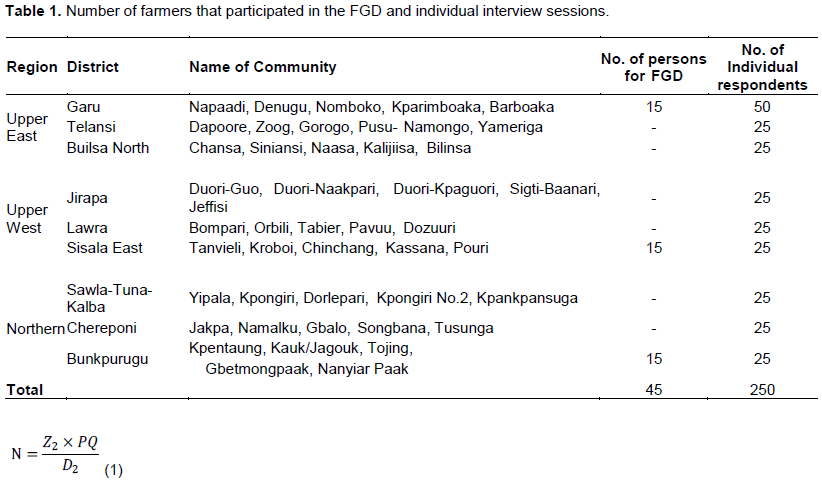
Where N = total number of farmers to be interviewed, Z = Confidence level of 95% (standard deviation of 1.96), P = estimated prevalence of farmers in the study area (80%), Q = 1-P, and D = margin of error of 5%. Even though this formula resulted in 245.8, the total sample size was adjusted to 250 respondents. Information captured using these tools included socio-demographic characteristics of the farmers, scale of pearl millet production, seed source, production operations, utilization, marketing, constraints and benefits derived from millet cultivation.
The Statistical Package for Social Sciences (IBM SPSS 26) was employed in analysing the data for statistical inferences and conclusions. The results were then presented in tables and graphs for interpretations.
RESULTS
Gender distribution
A majority of the respondents were men (208) constituting 83.20% while 16.80% (42) were women from all the regions (Table 2). The Upper East region recorded more men (86%) compared with Upper West and Northern region (82.7% and 80%), respectively, as respondents. At the district level, Sisala East district in Upper West region and Bunkpurugu district in Northern region recorded none of the respondents being women; while Builsa North and Talensi districts in the Upper East region each had 3 women.

Age, family size, marital status and educational level of respondents
A majority of the respondents across the regions were within the age of 40 to 60 years, followed by those below 40 years and then those above 60 years (49.6, 36.4, and 14%, respectively). Upper West did not only record the highest number of respondents below 40 years (44%) but also recorded the least number of those above 60 years (6.7%), indicating that a youthful population in the region are engaged in Agriculture compared with the other regions. Upper East region recorded the highest percentage of respondents being in the 40 to 50 years age range (39%), and was closely followed by the Northern region with 36%. In terms of family size, 46.08% (117) of the respondents had 6-10 members in a family (Table 3). Large family sizes were in the Upper West region with higher numbers coming from all the ages except 1-5. Upper East recorded the smallest family size, except for those with family size above 20 where it recorded a higher number than the Northern region (3 and 1.3%, respectively). Across the regions, only 5.60% of the respondents recorded more than 20 people living in a family.

While a majority of the respondents (61.6%) did not have a formal education, only 5.20% had a tertiary level education (Figure 1). The overall results revealed a decreasing trend from no formal education to tertiary level. Except for Northern and Upper West regions, the same trend was observed for the Upper East region.
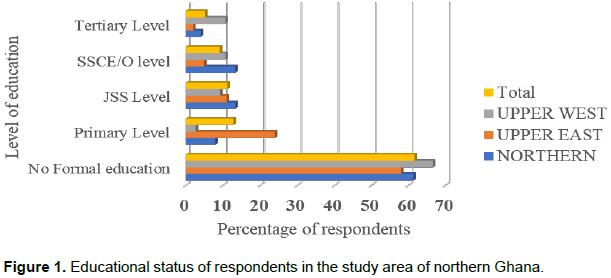
Figure 2 shows the average pearl millet yields from farmer fields. Results indicated that 166 farmers, representing 66.40%, of those interviewed across the regions reported yields between 1 and 3 maxi bags ac-1 (0.25-0.75 t ha-1), with few of them (11.20%) achieving yields above 6 bags ac-1 (1.50 t ha-1). Eighty-nine percent of farmers in Upper East region reported yields between 1 and 3 maxi bags (0.25-0.75 t ha-1) of millet on average. Half of the respondents in the Northern and Upper West regions (38 and 39, respectively) reported yields below 400 kg ac-1 (1.0 t ha-1); though others reported yields above 600 kg ac-1 (>1.50 t ha-1). More farmers (17) in the Northern region tend to record higher yields (>600 kg ac-1) than those in the Upper East region.

Results indicated that 31% of the respondents have been cultivating pearl millet for at least 21 years, 26% for 1 to 5 years; while only 8% have been growing the crop for at most 15 years (Table 4). Again, 18 and 16% of the respondents have been cultivating pearl millet between 6 and 10 years and 16 and 20 years, respectively.
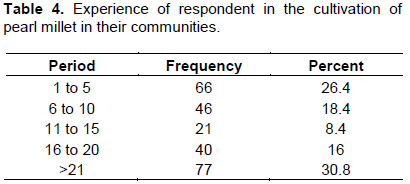
The study also reveals that an overwhelming majority of the respondents (60.4%) own more than 3 acres (>1.5 ha) of farmland; while 20% own less than one acre (Table 5). Sixty-eight percent of the farmers in the Northern region and 73% in Upper East region owned more than 1.5 ha of farmland. The results show that 72.8% of the respondents dedicated at least 25% of their farmland to pearl millet production each year; while 45.2% dedicated 25 to 50% of their farmland to pear millet production (Table 5). Again, 46.7% each of farmers in Northern and Upper West regions and 43% in Upper East region dedicate between 25 and 50% of their available crop land to pearl millet cultivation.
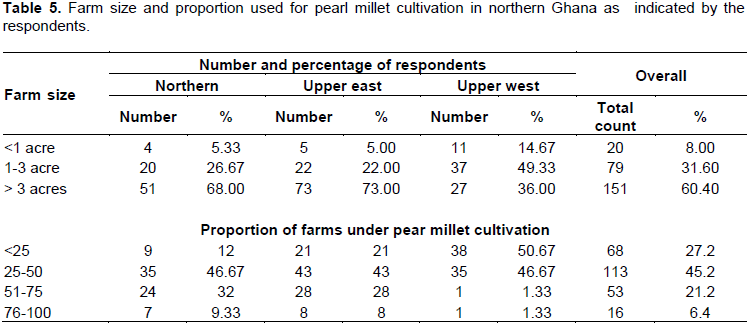
Results show that the majority of farmers in the regions practice intercropping, which is mainly cereal and cereal intercrop patterns (Table 6). For instance, 78.8% (first four from Table 6) of the farmers in the study area practice cereal intercropping, with only 21.2% growing sole cereals. It was found that 32% of the farmers performing intercropping grow early millet-late millet as part of an intercrop; and early millet-sorghum intercrop is the subsequent, which accounts for 24% of the farmers. Less than 1% of farmers grow early millet-maize intercrop. It was found that 80% of the farmers in Upper East region, 42.7% in Northern region and 41.3% in Upper West region practice early millet-late millet and early millet-Sorghum intercropping.
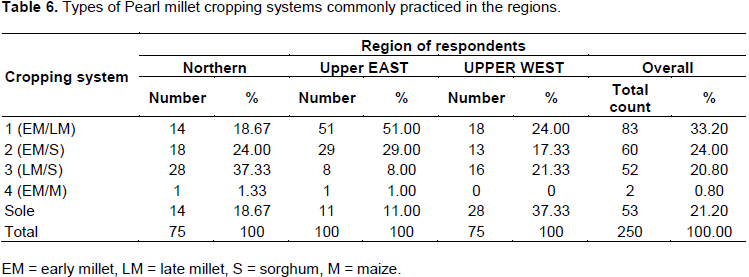
The results show that farmers have varied agronomic trait preferences in pearl millet production (Table 7). Across regions, a majority of the respondents considered yield (32%) and downy mildew disease incidence (17.6%) as the two main agronomic traits of importance. Early maturity was considered as the third most preferred trait across regions (16%). The trend is the same for the individual regions. However, seed colour and size were not mentioned as preferred traits in Northern and Upper West regions. Panicle length and shape were also not considered as preferred traits in the Upper west region.
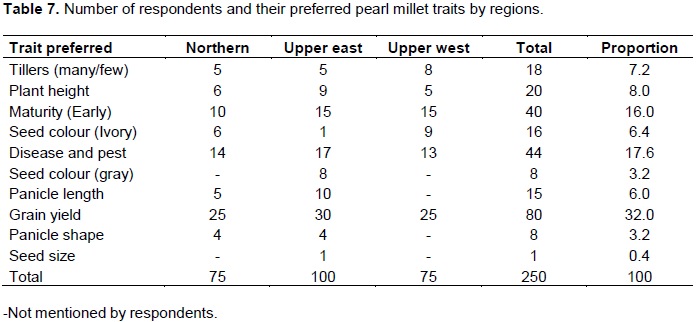
Low yields, and lack of improved seeds were ranked highest (ranked 1) in all regions, an indication that these two constraints were the driving force for improved and increased production and productivity in pearl millet (Table 8). Apart from low yields and lack of improved seeds, downy mildew and bird destruction were also ranked as important constraints in the Upper East region. The least important constraints in the Northern region were striga infestation and ease of threshing; while in the Upper East, land availability and ease of threshing were mentioned. Low soil fertility, bird destruction and land availability were the least important constraints in Upper West region. Striga infestation and low soil fertility were ranked low by farmers in the regions. In fact, in Upper West region, striga did not feature at all as a constraint; while in the Northern and Upper East regions it was ranked 5 and 3, respectively. During the FGD meeting, it was realized that improved seed, low yields and erratic rainfall pattern were ranked as the most critical constraint to pearl millet production across the agro-ecological zone. This was closely followed by downy mildew disease, low soil fertility, bird destruction and land availability with a rank of 2; while storage was ranked as the least of the critical variables.

An overwhelming majority of the pearl millet farmers (84%) recycle their seed; while 5.6 and 7.6% got their seed from friends and the open market, respectively (Table 9). Again, 2% of the respondents depended on research institutions; whereas, 0.4% depended on input dealers and MoFA/NGO for seed.

A majority of respondents (62.00%) rely mostly on pearl millet meals as food for their families (Table 10). Ninety-six percent (96%) of the population were ready to increase their current level of pearl millet production provided that the major constraints to production were addressed, including lack of improved seed relative to potential levels of increase. Whilst 96.4% of the population were willing to use improved seed generally, 80% were ready to purchase improved pearl millet seed for cultivation. Again, 97.00% of the respondents were willing to grow improved pearl millet seed with enhanced grain iron (Fe) and zinc (Zn) contents, even though a majority (78.00%) had no knowledge of any improved pearl millet seed in the system.

Correlation of some production variables
Correlation among some of the most critical variables shows significant association amongst them (Table 11). For instance, age of respondent, farm size and the number of years the respondent has been cultivating pearl millet were significantly positively correlated. While the size of farm land positively and significantly (p<0.001) influenced the proportion used for pearl millet cultivation, family size negatively and significantly influenced the proportion of land allotted to pearl millet production among farm families. However, gender distribution and grain yield did not significantly associate with the each other as well as the other variables.

DISCUSSION
The results showed that at least a majority of the respondents are pearl millet farmers, and thus have gained experience in its production. The current study revealed that pearl millet is an important part of the daily meals of majority of people of northern Ghana where it is eaten at least once every week. If the prevailing constraints such as lack of, and access to, improved seed, land availability among others were addressed; pearl millet crop farmers can increase their current level of production. Cereal crop production in northern Ghana is gender sensitive. A majority of peasants in northern Ghana are men because of land ownership characteristics (Sugri et al., 2017). This condition affects women’s access and use of agricultural lands for the crop of their choice. The situation becomes even worse where the family size is large, which is typical of Northern and Upper East regions (Sugri et al., 2017).
Pearl millet, one of the main cereal crops in Ghana, has a yield potential of between 2,000 kg ha-1 for OPVs and up to 3,600 kg ha-1 for hybrids. However, the currents trends, as revealed in this study, show that yield range of 250-750 kg ha-1 is achieved on farmers’ fields. There is, therefore, the need to explore the variations for possible yield increases in the locally available genotypes. According to earlier reports, pearl millet production in the country has seen a decline over the year (GSS, 2018, 2019; MoFA, 2019) and has been attributed to use of an indigenous landrace, which tends to be low yielding in low soil fertility; and the situation has become more problematic by substitution of pearl millet for crops such as maize and soybeans by some crop farmers. It is therefore, imperative to consider taking advantage of the existing genetic variations in some of the pearl millet landraces for improvement in the breeding programme in Ghana; since knowledge of the genetic variability, heritability and association among economic traits in existing local varieties is a pre-requisite for selection and development of a well-adapted variety for target environments (Afribeh et al., 2006; Jalata et al., 2011). Fortunately, many of the pearl millet farmers in Ghana have been cultivating it for over 20 years, as shown by the current study, and are therefore endowed with sufficient knowledge in the cultivation of the crop. Again, many of these farmers also own their own farmlands; hence, they do not entertain any fears of losing their investment to any landowner. Thus, they have dedicated a portion of their farmland, often not more than 2 ha, to pearl millet cultivation on a sustainable base. This confirms earlier reports that a majority of Ghanaian farmers own less than 2 ha of agricultural land on which most of their crops are cultivated annually (Bawa, 2019; GSS, 2018; Sugri et al., 2017; Tetteh et al., 2016). To address the limitation of land for production, a majority of farmers in the regions practice mixed cropping or intercropping. This was confirmed by this current study, which indicated that about 90% of the farmers in the Upper East region, in particular, practice early millet-late millet and early millet-sorghum intercropping systems; even on their limited available agricultural land that does not support mechanization, due to the area dedicated for such crops. Agricultural intensification is thus high among the farmers as a way to maximize returns as well as a form of insurance against unfavourable seasons that may affect some crop yields.
The education level of most of the peasant farmers of northern Ghana is very low causing many to shift into economic ventures such as farming, which does not often require high educational standards before one engages in its practices. This has led to northern Ghana being the labour hub for most agricultural activities, not only up north but also for many of the agricultural activities in southern Ghana. A majority of the respondents in the present study are in the productive age-group and were married. This, however, has negative effects on the living standards and the environment as reports suggest that people with high level of education are expected to have more income, and an enhanced livelihood, compared with those with little or no education (Nkegbe et al., 2017). Productive agricultural soils stand to be at risk of abuse by less educated farmers who have less chances of adopting soil conservation measures aimed at increased crop production (Tefera and Tefera, 2014).
High grain yield was the most preferred trait, followed by disease tolerance, many tillers, medium plant heights, and finally seed size as the least preferred trait across all regions. Farmers have their preferred traits in crops they cultivate, as reported in the current study, and are likely to hold on to a crop variety for a long time, if it serves the purpose. However, downy mildew disease is the most serious challenge of pearl millet farmers causing yield loss as high as 40% across the West African sub-region (Wilson et al., 2008). Therefore, breeding for high grain yield, earliness, and downy mildew control is important for the breeding program since these are the leading preferred traits of pearl millet as revealed in the present study.
As stated earlier, low yields due to low soil fertility or diseases, and lack of improved seeds are the driving forces against improved and increased production and productivity of pearl millet in Ghana. Earlier reports revealed that there is a lack of outlets for farmers to access improved seeds of released crop varieties (Etwire et al., 2013). Susceptibility to downy mildew disease was hampering the use of improved crop varieties in northern Ghana (Afribeh et al., 2006; Akromah et al., 2008; Asungre et al., 2015; Kanton et al., 2015). This causes many farmers to resort to recycled, or own saved seed, for sowing (Etwire et al., 2013; Sugri et al., 2013a). It must be pointed out that Striga weed resistance is one of the most preferred traits by pearl millet farmers (Dawud et al., 2017). However, in the current study this did not feature prominently as a constraint, probably since early maturing pearl millet in Ghana is usually harvested (latest in August) before Striga emergence in September.
From the participatory studies carried out in the pearl millet growing regions, it came to light that the production of this crop is plagued with many constraints. A product profile has thus been proposed as a way to ameliorate some of the identified constraints in the short-term period (Table 12). The way to achieve this lies in two prongs, which are breeding and introduction. The first step is to initiate contacts with the international centre like the International Crops Research Institute for the Semi-Arid Tropics (ICRISAT) for available advanced breeding lines or varieties for screening for the specific traits and possible release to farmers. Aside from this, the pearl millet breeding programme of the Council for Scientific and Industrial Research - Savanna Agricultural Research Institute (CSIR-SARI), will have to target these traits with urgency to come out with varieties that can fit in the agro-ecology of northern Ghana.
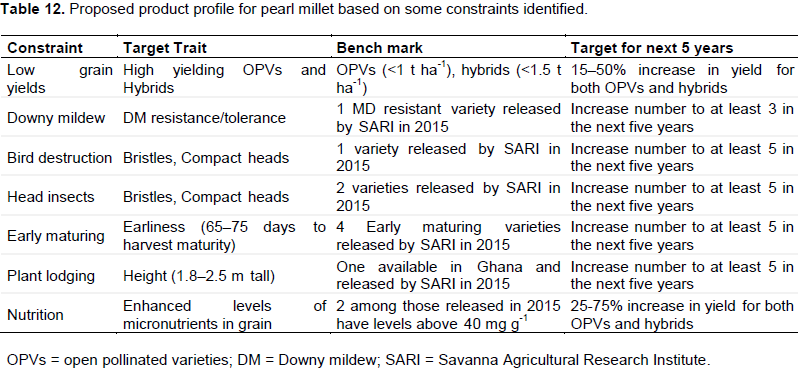
CONCLUSION
The cultivation of pearl millet in northern Ghana continues to serve as a stop-gap and source of food security measure against hunger of many subsistence farmers, as it is often harvested during periods of food shortage in many households in the area. However, over 90% of these farmers depend on their own saved seed-source due to lack of access to improved seeds and insufficiency of high yielding varieties that can replace existing landraces. Traits such as high yielding, early maturity, and tolerance to downy mildew disease were identified by farmers as important for improvement of pearl millet production to take advantage of the huge nutritional benefits that can be accrued from the consumption of pearl millet food products. The fact that there is a decline in the production of pearl millet in the country calls for a deliberate effort by the relevant stakeholders targeting these farmers with the available technologies such as improved varieties for improved production and productivity.
CONFLICT OF INTERESTS
The authors have not declared any conflict of interests.
ACKNOWLEDGEMENT
The authors express their gratitude to the pearl millet farmers in the zone for donating their time for the interviews and providing the primary information. The field staff of MoFA from all the regions who supported in the data collection is hereby appreciated.
REFERENCES
|
Afribeh D, Akromah R, Safo-Katanka O, Sarkodie-Addo J (2006). Genetic variation within Tongo Yellow. A Ghanaian pearl millet. International Journal of Sorghum and Millets Newsletter 47:14-15. |
|
|
Akromah R, Afribeh D, Abdulai MS (2008). Genetic variation and trait correlation in a bird-resistant pearl millet landrace population. African Journal of Biotechnology 7(12):1847-1850. |
|
|
Asungre AP, Akromah R, Atokple IDK (2015). Agro-Morphological Characterisation of Pearl Millet Accessions in Ghana. International Journal of Research in Agricultural Sciences 2(2):79-86. |
|
|
Bawa A (2019). Agriculture and Food Security in Northern Ghana. Asian Journal of Agricultural Extension, Economics and Sociology, September:1-7. |
|
|
Bennett-Lartey SO, Oteng-Yeboah AA (2008). Ghana Country Report on the State of Plant Genetic Resources for Food and Agriculture (Issue April):1-36. |
|
|
Burton GW (1985). Collection, evaluation and storage of pearl millet germplasm. Field Crops Research 11(C):123-129. |
|
|
Dawud MA, Angarawai II, Tongoona PB, Ofori K, Eleblu JSY, Ifie BE (2017). Farmers' Production Constraints, Knowledge of Striga and Preferred Traits of Pearl Millet in Jigawa State, Nigeria. Global Journal of Science Frontier Research: D Agriculture and Veterinary 17(3). |
|
|
Davies O (1968). The origins of agriculture in West Africa. Current Anthropology 9(5, Part 2):479-482. |
|
|
Dietz T, Millar D, Dittoh S, Obeng F, Ofori-Sarpong E (2004). Climate and Livelihood Change in North East Ghana. In AJ Dietz, R Ruben, A Verhagen (Eds.), The Impact of Climate Change on Drylands, with a Focus on West Africa. Dordrecht/Boston/London: Kluwer Academic Publishers. Environment and Policy Series 39:149-172. |
|
|
Dwivedi SL, Sahrawat KL, Rai KN, Blair MW, Hall E, Andersson MS, Pfeiffer W (2012). Nutritionally Enhanced Staple Food Crops. In Jules Janick (Ed.), Plant Breeding Reviews 36:169-291. John Willey & Sons, Inc. |
|
|
Etwire PM, Atokple IDK, Buah SSJ, Abdulai AL, Karikari AS, Asungre AP (2013). Analysis of the seed system in Ghana. International Journal of Advance Agricultural Research 1:7-13. |
|
|
Ghana Statistical Service, GSS (2018). Statistics for Development and Progress Provisional 2017 Annual Gross Domestic Product. Poverty Reduction Strategies in Action: Perspectives and Lessons from Ghana, Apri: 10. |
|
|
Ghana Statistical Service (GSS) (2019). 2017/18 Ghana Census of Agriculture: National Report. |
|
|
Jalata Z, Ayana A, Zeleke H (2011). Variability, Heritability and Genetic Advance for Some Yield and Yield Related Traits in Barley (Hordeum vulgare L.) Landraces in Ethiopia. International Journal of Plant Breeding and Genetics 5(1):44-52. |
|
|
Kanton RAL, Asungre AP, Ansoba EY, Inusah B, Bidzakin J, Abubakari M, Toah P, Haggan L, Totoe C, Akum F (2015). Evaluation of Pearl millet Varieties for Adaptation to the Semi-Arid Agro-Ecology of Northern Ghana. Journal of Agriculture and Ecology Research International 3(1):1-11. |
|
|
Khairwal I, Rai K, Diwakar B, Sharma Y, Rajpurohit B, Nirwan B, Bhattacharjee R (2007). Pearl Millet Crop Management and Seed Production Manual. Manual. International Crops Research Institute for the Semi-Arid Tropics, Patancheru, Andhra Pradesh, India. |
|
|
Ministry of Food and Agriculture (MoFA) (2011). Agriculture in Ghana: Facts and Figures 2010. In Ministry of Food and Agriculture-Ghana: Statistics, Research and Information Directorate http://mofa.gov.gh/site/wp-content/uploads/2011/10/AGRICULTURE-IN-GHANA-FF-2010.pdf |
|
|
Ministry of Food and Agriculture (MoFA) (2019). Agriculture in Ghana: Facts and figures 2018. In Ministry of Food and Agriculture- Ghana: Statistics, Research and Information Directorate. |
|
|
Nkegbe PK, Abu BM, Issahaku H (2017). Food security in the Savannah Accelerated Development Authority Zone of Ghana: An ordered probit with household hunger scale approach. Agriculture and Food Security 6(1):1-11. |
|
|
Rai OP, Yadav KN (2013). Genetic Improvement of Pearl Millet in India. Agricultural Research 2(4):275-292. |
|
|
Rao PP, Birthal PS, Reddy BVS, Rai KN, Ramesh S (2006a). Diagnostics of sorghum and pearl millet grains-based nutrition in India. International Sorghum and Millets Newsletter 47:93-96. |
|
|
Rao PP, Birthal PS, Reddy BVS, Rai KN, Ramesh S (2006b). Diagnostics of Sorghum and Pearl Millet Grains-based Nutrition in India. SAT EJournal by ICRISAT 2(1). |
|
|
Sugri I, Kanton RAL, Kusi F, Nutsugah SK, Buah SSJ, Zakaria M (2013a). Influence of Current Seed Programme of Ghana on Maize (Zea mays) Seed Security. Reserach Journal of Seed Sciences 6(2):29-39. |
|
|
Sugri I, Kusi F, Kanton RAL, Nutsugah SK, Zakaria M (2013b). Sustaining Frafra Potato (Solenostemon rotundifolius Poir.) in the Food Chain; Current Opportunities in Ghana. Journal of Plant Sciences 1(4):68-75. |
|
|
Sugri I, Maalekuu BK, Gaveh E, Kusi F (2017). Sweet Potato Value Chain Analysis Reveals Opportunities for Increased Income and Food Security in Northern Ghana. Advances in Agriculture, 1-14. |
|
|
Tefera T, Tefera F (2014). Determinants of Households Food Security and Coping Strategies for Food Shortfall in Mareko District, Guraghe Zone Southern Ethiopia. Journal of Food Security 2(3):92-99. |
|
|
Tetteh F, Larbi A, Nketia KA, Senayah JK, Hoeschle-Zeledon I, Abdul-Rahman N (2016). Suitability of soils for cereal cropping in Northern Ghana. International Institute of Tropical Agriculture, July, 5. |
|
|
Tortoe C, Akonor PT, Hagan L, Kanton RAL, Asungre AP, Ansoba EY (2019). Assessing the suitability of flours from five pearl millet (Pennisetum americanum) varieties for bread production. International Food Research Journal 26(1):329-336. |
|
|
Wilson JP, Sanogo MD, Nutsugah SK, Angarawal I, Fofana A, Traore A, Ahmadou I, Muuka FP (2008). Evaluation of pearl millet for yield and downy mildew resistance across seven countries in sub-Saharan Africa. African Journal of Agricultural Research 3(5):371-378. |
|
Copyright © 2024 Author(s) retain the copyright of this article.
This article is published under the terms of the Creative Commons Attribution License 4.0